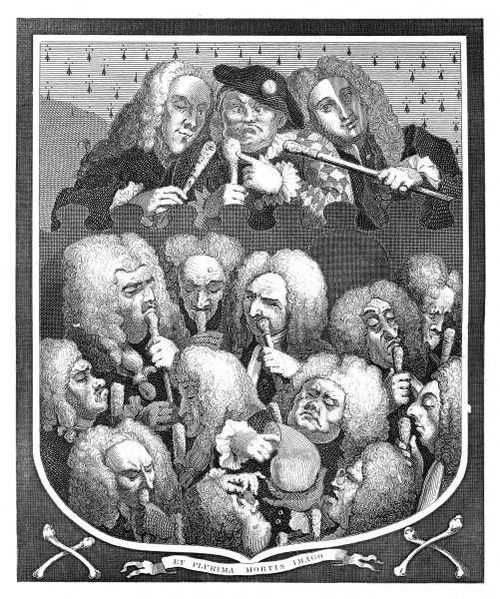








This plate is designed, with much humour, according to the rules of heraldry, and is called The Undertakers' Arms, to show us the connexion between death and the quack doctor, as are also those cross-bones on the outside of the escutcheon. When an undertaker is in want of business, he cannot better apply than to some of those gentlemen of the faculty, who are, for the most part, so charitably disposed, as to supply the necessities of these sable death-hunters, and keep them from starving in a healthy time. By the tenour of this piece, Mr. Hogarth would intimate the general ignorance of such of the medical tribe, and teach us that they possess little more knowledge than their voluminous wigs and golden-headed canes. They are represented in deep consultation upon the contents of an urinal. Our artist's own illustration of this coat of arms, as he calls it, is as follows: "The company of undertakers beareth, sable, an urinal, proper between twelve quack heads of the second, and twelve cane heads, or, consultant. On a chief,Nebulæ, ermine, one complete doctor, issuant, checkie, sustaining in his right hand a baton of the second. On the dexter and sinister sides, two demi-doctors, issuant of the second, and two cane heads, issuant of the third; the first having one eye, couchant, towards the dexter side of the escutcheon; the second faced, per pale, proper, and gules guardant. With this motto, Et plurima mortis imago. The general image of death."
It has been said of the ancients, that they began by attempting to make physic a science, and failed; of the moderns, that they began by attempting to make it a trade, and succeeded. This company are moderns to a man, and, if we may judge of their capacities by their countenances, are indeed a most sapient society. Their practice is very extensive, and they go about, taking guineas,
Many of them are unquestionably portraits, but as these grave and sage descendants of Galen are long since gone to that place where they before sent their patients, we are unable to ascertain any of them, except the three who are, for distinction, placed in the chief, or most honourable part of the escutcheon. Those who, from their exalted situation, we may naturally conclude the most distinguished and sagacious leeches of their day, have marks too obtrusive to be mistaken. He towards the dexter side of the escutcheon, is determined by an eye in the head of his cane to be the all-accomplished Chevalier Taylor, in whose marvellous and surprising history, written by his own hand, and published in 1761, is recorded such events relative to himself and others, as have excited more astonishment than that incomparable romance, Don Belianis of Greece, the Arabian Nights, or Sir John Mandeville's Travels.
The centre figure, arrayed in a harlequin jacket, with a bone, or what the painter denominates a baton, in the right hand, is generally considered designed for Mrs. Mapp, a masculine woman, daughter to one Wallin, a bone-setter at Hindon, in Wiltshire. This female Thalestris, incompatible as it may seem with her sex, adopted her father's profession, travelled about the country, calling herself Crazy Sally; and, like another Hercules, did wonders by strength of arm.
On the sinister side is Dr. Ward, generally called Spot Ward, from his left cheek being marked with a claret colour. This gentleman was of a respectable family, and though not highly educated, had talents very superior to either of his coadjutors.
For the chief, this must suffice; as for the twelve quack heads, and twelve cane heads, or, consultant, united with the cross bones at the corners, they have a most mortuary appearance, and do indeed convey a general image of death.
In the time of Lucian, a philosopher was distinguished by three things,—his avarice, his impudence, and his beard. In the time of Hogarth, medicine was a mystery, and there were three things which distinguished the physician,—his gravity, his cane-head, and his periwig. With these leading requisites, this venerable party are most amply gifted. To specify every character is not necessary; but the upper figure on the dexter side, with a wig like a weeping willow, should not be overlooked. His lemon-like aspect must curdle the blood of all his patients. In the countenances of his brethren there is no want of acids; but, however sour, each individual was in his day,
 CONSULTATION OF PHYSICIANS.
CONSULTATION OF PHYSICIANS.